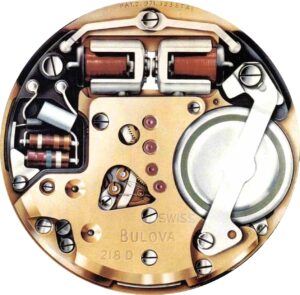 |
Brand: | Bulova | 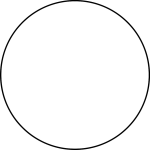
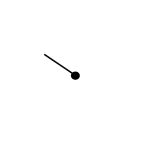
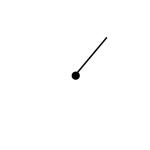
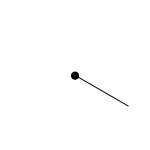
|
|---|---|---|---|
| Family: | |||
| Height: | 4.9 mm | ||
| Jewels: | 15 | ||
| Reserve: | hours | ||
| Frequency: | 360 Hz | ||
| Winding: | Battery | ||
| Diameter: | 29.7 mm (13 ligne) | ||
| © Europa Star Bulova Accutron 218D | Complications: | Date, Day, GMT Hand, Hacking Seconds | |
| Hands: | Central Hour Hand, Central Minute Hand, Central Seconds Hand | ||
| Distinguishing Technical Characteristics | |||||||||||
|---|---|---|---|---|---|---|---|---|---|---|---|
| Production: 1967 – 1977 | |||||||||||
| 1910s | 1920s | 1930s | 1940s | 1950s | 1960s | 1970s | 1980s | 1990s | 2000s | 2010s | 2020s |
Cal. 218 was the second-generation Accutron movement from Bulova. Introduced in 1967, it incorporated many updates to the original, notably the addition of a calendar complication. Some versions feature a day and date, a second timezone, a 24 hour hand, and an independently-adjustable hour hand. These were the most widely-produced Accutron movements and remain the most common today.
Cal. 218 measures 29.7 mm diameter like its predecessor, but is thinner at 4.9 mm. Although the tuning fork still vibrates at 360 Hz, the index wheel now has 320 teeth rather than 300 and the wheel train is different. The electronic design is similar, though a Silicon NPN transistor is always used and a resistor is added.
Note that most Accutron watches placed the crown at 4:00 rather than 3:00. The Astronaut Mark II model, Cal. 2185, with an independently-adjustable hour hand, had a second crown at 2:00.
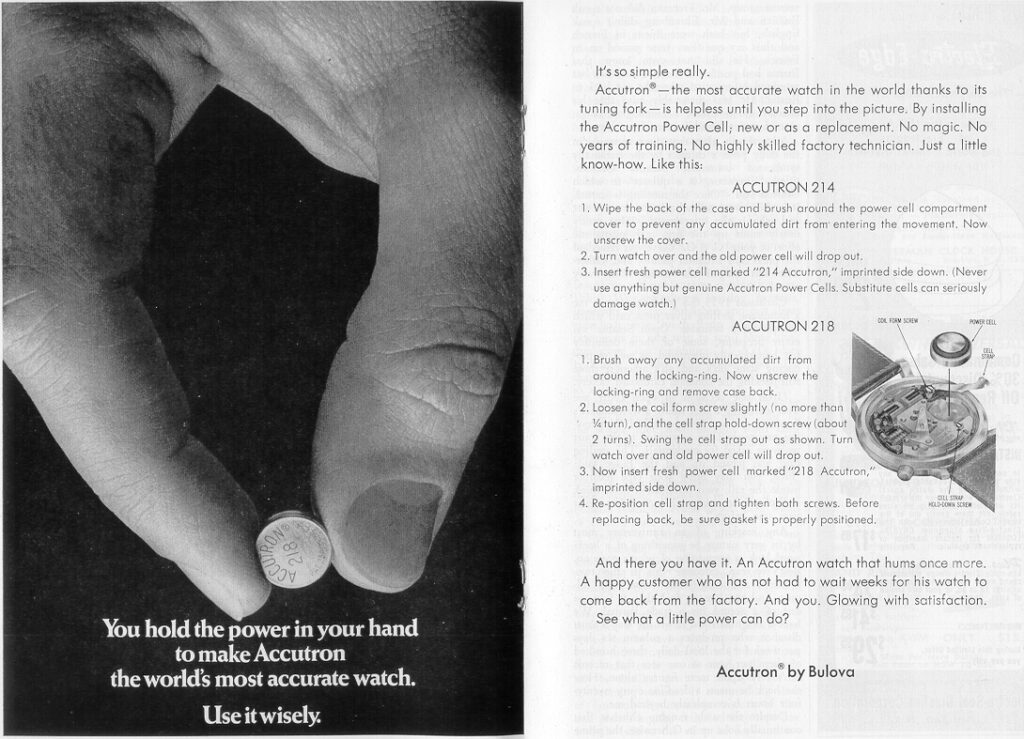
The original Cal. 218 had an entirely different hacking feature from the earlier Cal. 214. In these movements, the tuning fork keeps running when the crown is pulled, though the pawl finger is no longer in contact with the index wheel. This is the system found on the basic Cal. 218, along with the derived Cals. 2180, 218D, 2181, and 2182. Cal. 218F has a different hacking mechanism which interrupts the current flow, saving battery power when the crown is pulled.

Cal. 218G was produced in Japan by the joint-venture Bulova-Citizen Watch Co. These are mostly identical to American-produced Accutron Cal. 218 movements, and parts are interchangeable between them. These are stamped “Lic. Bulova” on the plate, since they were produced under license. They also feature the original hacking pin and a new three-position crown, with the middle position leaving the watch running while setting the hands and the third position interrupting the electrical current.
Variants
- Bulova
- 218
- 218D (with date)
- 2180 (no calendar)
- 2181 (with date)
- 2181F (modified hacking spring)
- 2182 (with day and date)
- 2182F (modified hacking spring)
- 2183 (no calendar or seconds hand)
- 2183F (modified hacking spring)
- 2185 (“Astronaut Mark II” with “home time” and independent “away time” hour hands and second crown at 2:00)
- 2186 (“Direct Read” digital discs)
- 218S
- 218SC
- Bulova-Citizen
- 218G (no calendar)
- 2181G (with date)
- 2182G (with day and date)
- 2183G (no calendar or seconds hand)
- Citizen – Introduced in 1971
- Hi-Sonic, 15 jewels
- Time-Only, 4.4 mm thick: 3721A, 3722A
- Date, 4.9 mm thick: 3710A, 3711A
- Day/Date 5.48 mm thick: 3700A, 3701A, 3702A
- Cosmotron GX, 11 jewels
- Day/Date, 5.58 mm thick: 3701B
- Hi-Sonic, 15 jewels
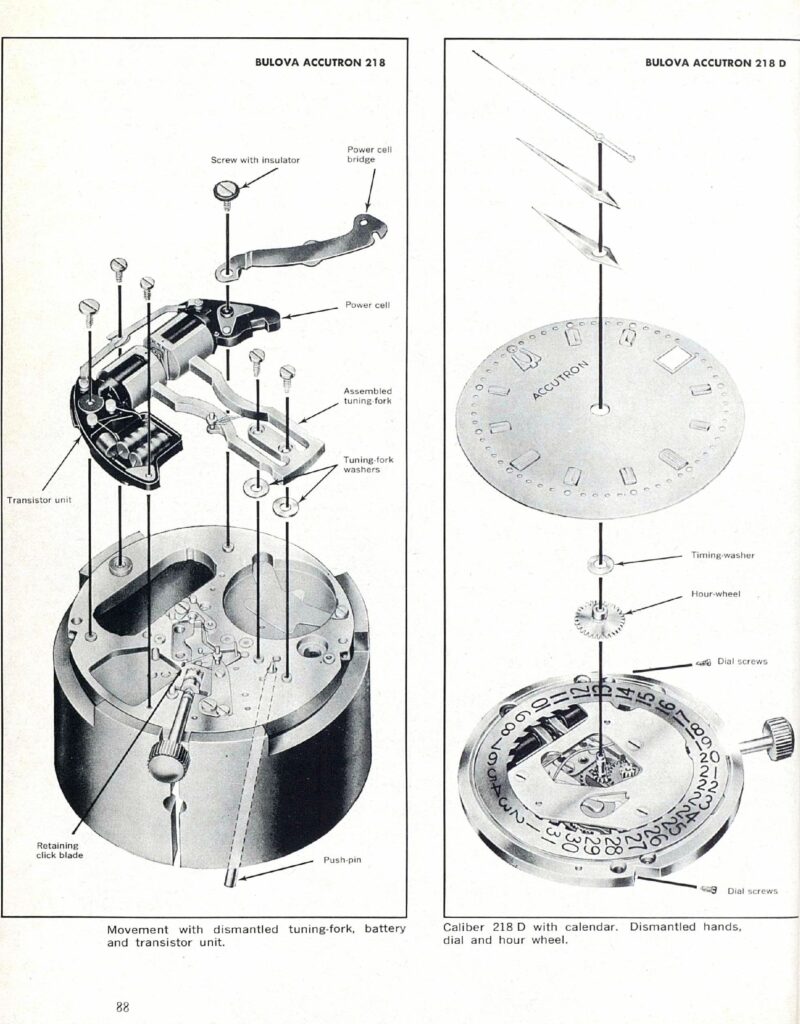
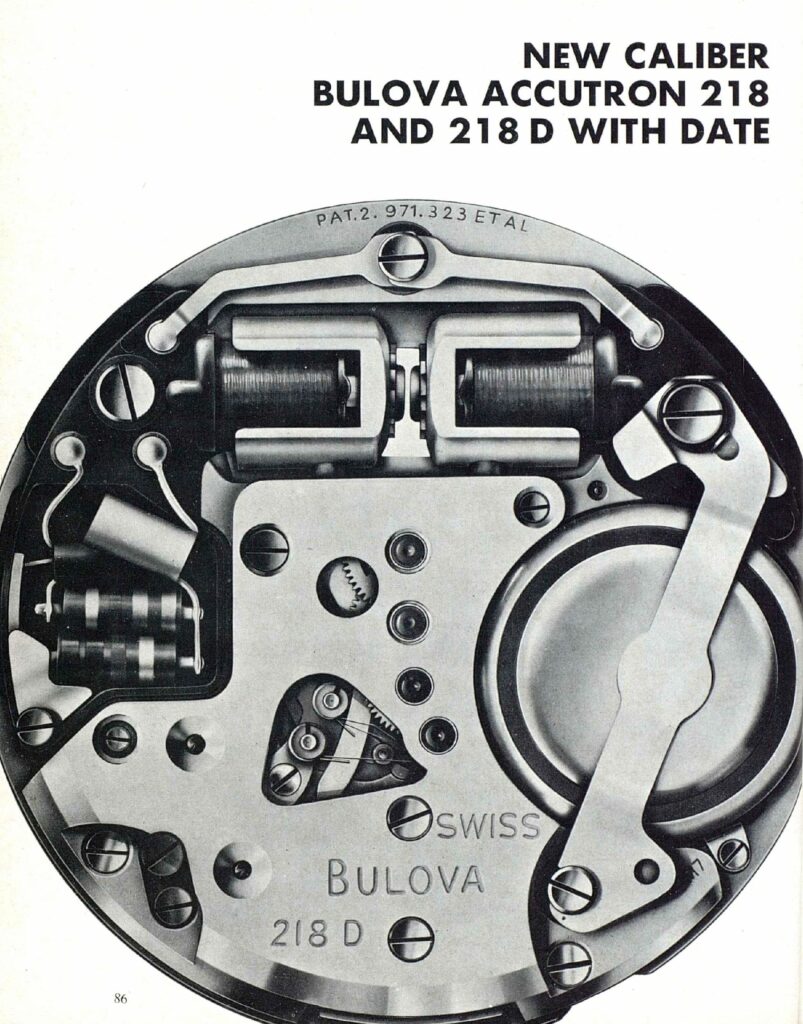
History of the Bulova Accutron and Tuning Fork Movements
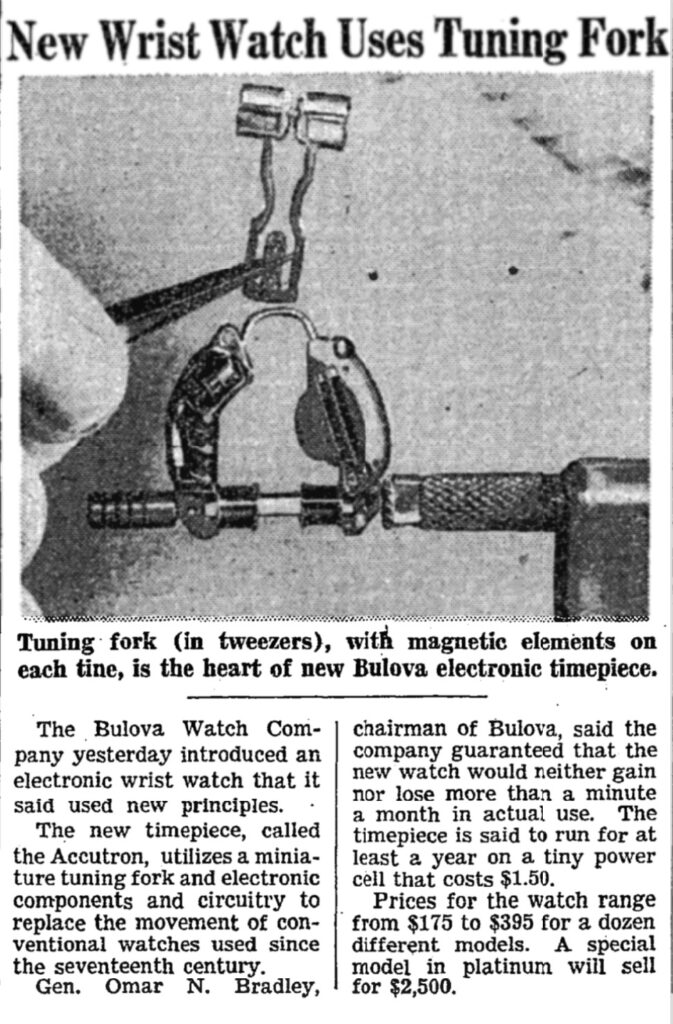
Image: New York Times, October 26, 1960
The tuning fork concept was developed by Swiss engineer, Max Hetzel, who went to work for Bulova in 1950. He completed a working model of the movement in 1953 and his department created a number of prototypes as well. By 1955, eight watch-sized prototypes were being tested inside the company and Bulova transferred the project to New York. After a series of difficulties, Hetzel was offered a position William Bennett’s group in New York to help complete the movement.
The design of the original Accutron movement was finalized in the latter half of the 1950s, with Bulova placing tuning fork timers on early spacecraft and satellites. An Accutron timer was placed in the Explorer VI and Explorer VII unmanned orbiters in 1959 and another was used to switch transmission of data aboard Explorer XI on April 27, 1961. Accutron timers and watches would later be used on satellites (Telstar, Tiros, Syncom, Pegasus, and LES), in spacecraft (Explorer, Mercury, Gemini, Agena, and Apollo), and on the wrists of astronauts.
The Accutron Cal. 214 debuted to much fanfare at a press conference on October 25, 1960. The Basel Fair in 1961 featured production Bulova Accutron watches, and sales started later in the year. The company sold over 100,000 units in two years, increasing this to 250,000 more in the next two years. The Accutron truly was a product no other company could match.

With quartz watches still a few years from commercialization, Bulova was able to force the entire industry to transform. In 1966, Bulova merged with the maker of Universal Genève, giving a strong new channel especially in Europe. Inventor Max Hetzel moved to Ebauches SA in 1963, and the Swiss watch giant licensed the technology from Bulova in 1968 to bring their own “Swissonic” tuning fork movement to market, as well as the later 720 Hz “Megasonic”. Bulova set up a manufacturing agreement with Citizen of Japan in 1960, moving some production there, and they too licensed and produced their own tuning fork movements in a joint-venture company starting in 1970.
Bulova continued to refine the Accutron movement until it was discontinued in 1977. In 1967, they introduced the second-generation Accutron movement. Cal. 218 and 218D (with date) were thinner and incorporated many of the changes made to Cal. 214 over the previous 7 years. A day/date model appeared in 1969. 1970 saw both a compact ladies model and a version with a second timezone display. A “mini Accutron” came in 1973.
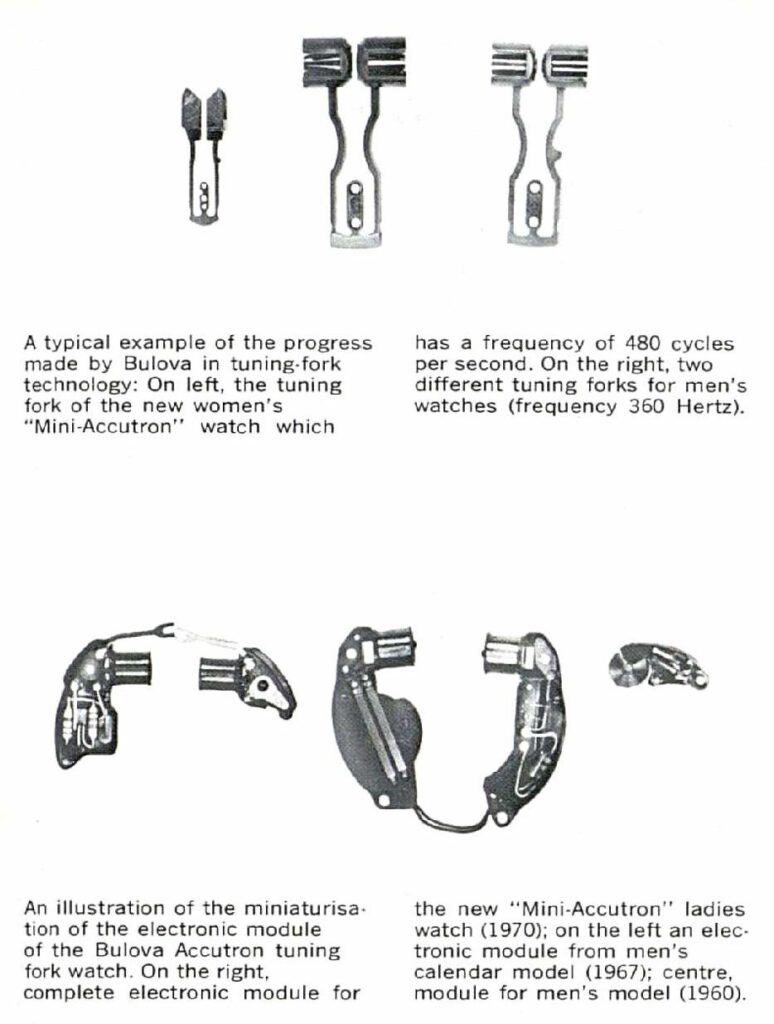
Bulova was caught off-guard by the rise of quartz movements. The original Swiss Beta 21 movement had some elements in common with tuning fork movements, and Bulova incorporated a quartz crystal into the Accutron base, creating the Accuquartz in 1970, which used a quartz crystal to regulate the tuning fork. This was the first “quartz” watch available in America, and sold reasonably well until cheaper Japanese quartz movements became widespread.
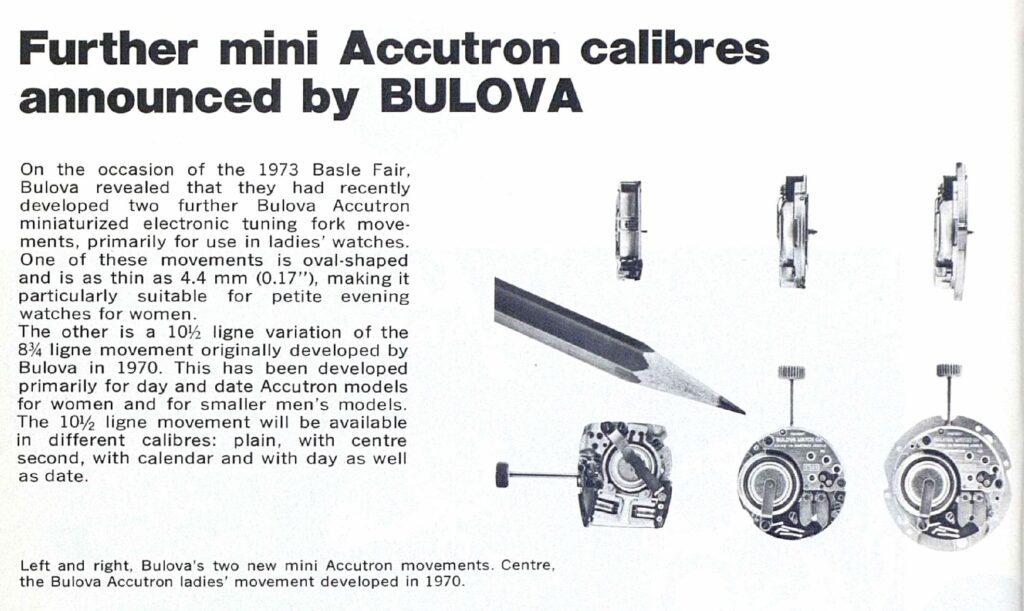
Bulova was acquired by Loews Corporation in 1979, primarily for their military and industrial products. In 2008, Citizen Holdings purchased Bulova, uniting the companies that had been partners since 1960. Today, the Accutron brand remains Bulova’s flagship watch line, though the tuning fork movement has not been produced since 1977, apart from a hand-made limited-edition 50th anniversary reissue in 2010.
Images are taken from official publications and are used here for commentary and educational purposes. Copyright is held by the original owner as noted.